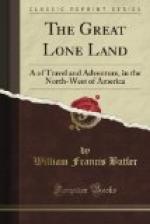Matters were in this state when, in 1812, as we have already seen in an earlier chapter, the Earl of Selkirk, a large proprietor of the Hudson Bay Company, conceived the idea of planting a colony of Highlanders on the banks of the Red River near the lake called Winnipeg.
Some great magnate was intent on making a deer forest in Scotland about the period that this country was holding its own with difficulty against Napoleon. So, leaving their native parish of Kildonan in Sutherlandshire, these people established another Kildonan in the very heart of North America, in the midst of an immense and apparently boundless prairie. Poor people! they had a hard time of it-inundation and North-west Company hostility nearly sweeping them off their prairie lands. Before long matters reached a climax. The North-west Canadians and half-breeds sallied forth one day and attacked the settlers; the settlers had a small guard in whose prowess they placed much credence; the guard turned out after the usual manner of soldiers, the half-breeds and Indians lay in the long grass after the method of savages. For once the Indian tactics prevailed. The Governor of the Hudson Bay Company and the guard were shot down, the fort at Point Douglas on the Red River was taken, and the Scotch settlers driven out to the shores of Lake Winnipeg.
To keep the peace between the rival companies and the two nationalities was no easy matter, but at last Lord Selkirk came to the rescue; they were disbanding regiments after the great peace of 1815, and portions of two foreign corps, called De Muiron’s and De Watteville’s Regiments, were induced to attempt an expedition to the Red River.
Starting in winter from the shores of Lake Superior, these hardy fellows traversed the forests and frozen lakes upon snow-shoes, and, entering from the Lake of the Woods, suddenly appeared in the Selkirk Settlement, and took possession of Fort Douglas.




